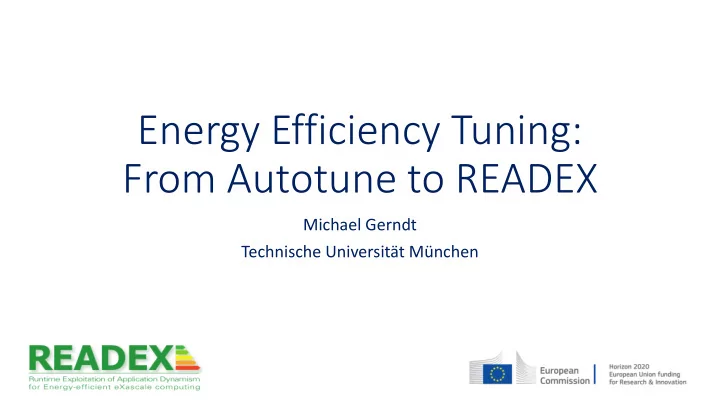

Energy Efficiency Tuning: From Autotune to READEX Michael Gerndt Technische Universität München
Project overview • READEX R untime E xploitation of A pplication D ynamism for E nergy-efficient e X ascale Computing • Starting date: 1. September 2015 • Duration: 3 years • Funding: European Commission Horizon 2020 grant agreement 671657 2
Project partners 3
Motivation Challenges • Energy consumption • Extreme scale Problems • Dynamism • Awareness • Ability Solution • Effort • Dynamism • Automatic tuning • Design-/Run-time 4
General idea HPC Embedded • Automatic Tuning • System Scenarios
Systems scenarios • System Scenario based Methodology • Formalism for dynamic auto-tuning in the embedded systems world • Detect and analyze dynamism in applications at design-time • Switch parameters at run-time based on detected scenarios 6
Periscope Tuning Framework • Automatic application analysis & tuning • Tune performance and energy (statically) • Plug-in-based architecture • Evaluate alternatives online • Scalable and distributed framework • Support variety of parallel paradigms • MPI, OpenMP, OpenCL, Parallel pattern • Developed in the Autotune EU-FP7 project 7
Score-P • Scalable Performance Measurement Infrastructure for Parallel Codes • Common instrumentation and measurement infrastructure 8
ENOPT library implemented by LRZ
Tuning Plugin Interface Scenario execution Search Space Exploration Tuning Step Application Tuning Periscope Plugin with Frontend actions Monitor Analysis strategies
Tuning Plugins • MPI parameters • Eager Limit, Buffer space, collective algorithms • Application restart or MPIT Tools Interface • DVFS • Frequency tuning for energy delay product • Model-based prediction of frequency • Region level tuning • Parallelism capping • Thread number tuning for energy delay product • Exhaustive and curve fitting based prediction
Tuning Plugins • Master/worker • Partition factor and number of workers • Prediction through performance model based on data measured in pre- analysis • Parallel Pattern • Tuning replication and buffers between pipeline stages • Based on component distribution via StarPU • OpenCL tuning • Compiler flags for offline compilation • NDRange tuning
Tuning Plugins • MPI IO • Tuning data sieving and number of aggregators • Exhaustive and model based • Compiler Flag Selection • Automatic recompilation and execution • Selective recompialtion based on pre-analysis • Exhaustive and individual search • Scenario analysis for significant routines • Combination with Pathway
Plugin Evaluation Status
Variation of Measurements 15
Predicted vs Measured Time for Seissol 16
Tuning with Persicope Tuning Framework 17
Dynamism • Intra-phase • Inter-phase 18
PEPC Benchmark of the DEISA Benchmark Suite All-to-all Performance 2048 phases 19
Inter-phase Dynamism • Indeed application of GNS • Identifiers for • adaptation strategy • Valleys vs hills 20
Scenario-Based Tuning Design Time Analysis Periscope Tuning Framework (PTF) Runtime Scenarios with Tuning Model RunTime Tuning READEX Runtime Library (RRL) 21
Terminology • Significant Regions : Coarse-granular code regions • Runtime Situations : Instances of significant regions • Identifiers : Distinguish rts ' s with different characteristics • Region ID, Call path, region parameters, phase identifiers, input identifiers • Scenarios : rts ' s with same characteristics • Tuning Model : • Set of scenarios • Classifier based on the identifiers • Selector for each scenario Yury Oleynik | oleynik@in.tum.de 22
Design Time Analysis with Periscope 23
Runtime Tuning with the READEX Runtime Library
Validation and project goals • Goal: Validate the effect of READEX using real-world applications • Co-design process: • Hand-tune selected applications • Compare results with automatic static and dynamic tuning • Energy measurements using HDEEM infrastructure 25
Conclusion • Energy-efficiency at exascale • Application developers and users will have to care • Lack of capabilities • Awareness • Expertise • Resources • Proposed solution – READEX: • Exploit dynamism • Detect at design-, exploit at run-time • Tools-aided auto-tuning methodology Yury Oleynik | oleynik@in.tum.de 26
Thank you! Questions? Yury Oleynik | oleynik@in.tum.de 27
Recommend
More recommend